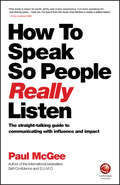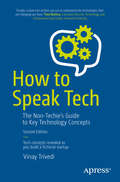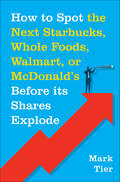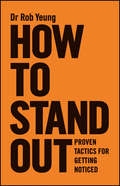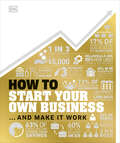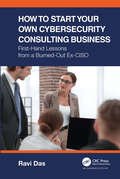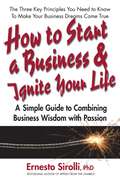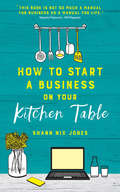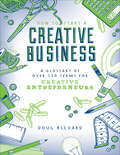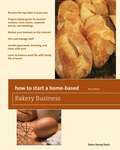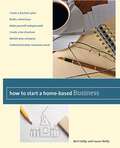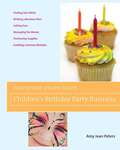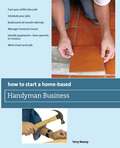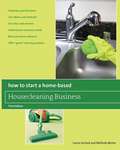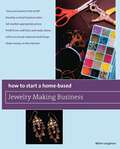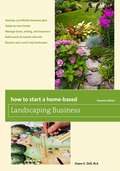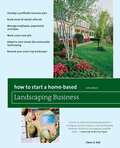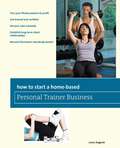- Table View
- List View
How to Speak So People Really Listen: The Straight-Talking Guide to Communicating with Influence and Impact
by Paul McgeeLearn how to inspire your audience with best-selling author Paul McGee! Everyday we're faced with situations where we have to speak to or persuade others. You might be an expert on your topic, you might be the most confident presenter going, but do you struggle to get your audience engaged and inspired by what you're saying? Paul McGee has 20 years' experience as a presenter and can show you how to speak so people really listen; a vital skill that can have a huge impact on your career and personal success. Learn to recognise the 7 most common mistakes made by speakers and presenters and more importantly, learn how to avoid them. Written in Paul's down to earth and approachable style, How to Speak so People Really Listen will: Teach you how to deal with nerves Show you what your body language says about you Inspire you to speak with clarity for ultimate impact Give you 15 powerful and practical strategies to get your audience to sit up and shut up when you stand up to speak
How to Speak Tech: The Non-Techie’s Guide to Key Technology Concepts
by Vinay TrivediThings you’ve done online: ordered a pizza, checked the weather, booked a hotel, and reconnected with long-lost friends. Now it’s time to find out how these things work. Vinay Trivedi peels back the mystery of the Internet, explains it all in the simplest terms, and gives you the knowledge you need to speak confidently when the subject turns to technology. This revised second edition of How to Speak Tech employs the strategy of the popular first edition: through the narrative of setting up a fictitious startup, it introduces you to essential tech concepts. New tech topics that were added in this edition include the blockchain, augmented and virtual reality, Internet of Things, and artificial intelligence.The author’s key message is: technology isn’t beyond the understanding of anyone! By breaking down major tech concepts involved with a modern startup into bite-sized chapters, the author’s approach helps you understand topics that aren’t always explained clearly and shows you that they aren’t rocket science. So go ahead, grab this book, start to “speak tech,” and hold your own in any tech-related conversation!What You'll LearnUnderstand the basics of new and established technologies such as blockchain, artificial intelligence (AI), augmented and virtual reality (AR and VR), Internet of Things (IoT), software development, programming languages, databases, and moreListen intelligently and speak confidently when technologies are brought up in your businessBe confident in your grasp of terms and technologies when setting up your own organization's applicationWho This Book Is ForStudents who want to understand different technologies relevant to their future careers at startups and established organizations, as well as business and other non-technical professionals who encounter and require an understanding of key technical terms and trends to succeed in their rolesReviews“Finally, a book non-techies can use to understand the technologies that are changing our lives.” Paul Bottino, Executive Director, Technology and Entrepreneurship Center, Harvard University“A great book everyone can use to understand how tech startups work.” Rene Reinsberg, Founder at Celo; Former VP of Emerging Products, GoDaddy“Through the simplicity of his presentation, Vinay shows that the basics of technology can be straightforwardly understood by anyone who puts in the time and effort to learn.” Joseph Lassiter, Professor of Management Science, Harvard Business School and Harvard Innovation Lab
How to Spot the Next Starbucks, Whole Foods, Walmart, or McDonald's Before its Shares Explode
by Mark TierEveryone knows the basic golden rule of investing: “Buy Low, Sell High,” but how many of us ever really understand the stock market, how to recognize the “next big thing,” and how to capitalize off of it once you do? ...the truth is not many or we’d all be millionaires. It seems like early investors in big companies like Facebook and Google had to have won the lottery of investing and just gotten really lucky, but there’s more to it than that. There’s a science to the “Next Big Thing” strategy, and Mark Tier understands it. In How to Spot the Next Starbucks, Whole Foods, Walmart, or McDonald's BEFORE Its Shares Explode, Tier shows readers that explosive brands like Starbucks, Whole Foods, McDonald's, and Walmart didn’t become successful on accident. Through in-depth and accessible case studies, Tier pulls back the curtain on the early Key Performance Indicators that each of these major companies showed even at their earliest stages. Once you learn how to recognize these makings of success, you too will be able to spot the next Starbucks.
How to Stand Out
by Rob YeungWin the respect you deserve You probably already have the skills to be more fulfilled and successful. But sometimes it's about showcasing these skills so that colleagues, customers, friends and the rest of the world can recognize what you do.Drawing on extensive research and inspiring real-life examples, psychologist and bestselling author Dr. Rob Yeung guides you through proven techniques that will get you noticed for all the right reasons.
How to Start & Run Your Own Bed & Breakfast Inn
by Carl Glassman Ripley Hotch• All the knowledge needed for running a profitable business• Revised and updated with new information on computers, the Internet, and cell phonesExperienced and first-time innkeepers need reliable information to help them meet the challenges of running a successful inn. This book reveals the secrets of the best inns, including information on securing financing, buying and managing the inn, attracting the right guests, developing a business plan, addressing legal and insurance needs, marketing the inn effectively, and locating professional organizations.
How to Start Your Own Business: The Facts Visually Explained (DK How Stuff Works)
by DKThis is your foolproof guide on how to make your start-up stand out from the crowd!Get professional business advice in the palm of your hands. This uniquely visual guide equips you with everything you need to know about setting up and running your own business.Are you looking to start a business? You&’ll need advice on how to identify your customer, what pitfalls to anticipate, and how best to spend your time and money to turn your idea into a profitable venture. This insightful business book takes you through everything from balancing the books to building a brand. It inspires you to take that giant leap towards making your entrepreneurial dreams come true.The Simplest, Most Visual Guide to Becoming an Entrepreneur - Ever!This comprehensive guide to starting your own business acts as an invaluable blueprint for your path to business success. It&’s the ultimate gift for entrepreneurs or anyone who wants to learn more about the world of business management.This informative reference book is packed with:- Practical, authoritative information on the skills required to run a small business.- Easy-to-understand graphics.- No-nonsense advice and jargon-free language.- Insightful and inspiring quotes from the most successful minds in business.This entrepreneur book gives you all the tools you need to understand how a modern start-up works and then start your own. Whether you're a CEO or an aspiring tech entrepreneur, the information and advice in How To Start Your Own Business can be applied to anyone.Complete the Series:This guide to setting up a small business is part of the How It Works Series from DK Books. Expand your knowledge about business and management even further with How Business Works and How Management Works.
How to Start Your Own Cybersecurity Consulting Business: First-Hand Lessons from a Burned-Out Ex-CISO
by Ravi DasThe burnout rate of a Chief Information Security Officer (CISO) is pegged at about 16 months. In other words, that is what the average tenure of a CISO is at a business. At the end of their stay, many CISOs look for totally different avenues of work, or they try something else – namely starting their own Cybersecurity Consulting business. Although a CISO might have the skill and knowledge set to go it alone, it takes careful planning to launch a successful Cyber Consulting business. This ranges all the way from developing a business plan to choosing the specific area in Cybersecurity that they want to serve. How to Start Your Own Cybersecurity Consulting Business: First-Hand Lessons from a Burned-Out Ex-CISO is written by an author who has real-world experience in launching a Cyber Consulting company. It is all-encompassing, with coverage spanning from selecting which legal formation is most suitable to which segment of the Cybersecurity industry should be targeted. The book is geared specifically towards the CISO that is on the verge of a total burnout or career change. It explains how CISOs can market their experience and services to win and retain key customers. It includes a chapter on how certification can give a Cybersecurity consultant a competitive edge and covers the five top certifications in information security: CISSP, CompTIA Security+, CompTIA CySA+, CSSP, and CISM. The book’s author has been in the IT world for more than 20 years and has worked for numerous companies in corporate America. He has experienced CISO burnout. He has also started two successful Cybersecurity companies. This book offers his own unique perspective based on his hard-earned lessons learned and shows how to apply them in creating a successful venture. It also covers the pitfalls of starting a consultancy, how to avoid them, and how to bounce back from any that prove unavoidable. This is the book for burned-out former CISOs to rejuvenate themselves and their careers by launching their own consultancies.
How to Start a Business & Ignite Your Life
by Ernesto SirolliHave you ever wondered why companies such as Apple, Disney, eBay, and Starbucks succeeded? What common factors did they—and most other successful startups—share? Dr. Ernesto Sirolli, one of the world&’s leading consultants on the topic of economic development, has the answer: None of the entrepreneurs who founded the world&’s greatest companies did it on their own. They put together an effective team that allowed their ventures to get off the ground, flourish, and grow. And in his new book, How to Start a Business & Ignite Your Life, Ernesto Sirolli has written down an easy-to-follow formula for success so that passionate people can transform their ideas into thriving businesses.Ernesto Sirolli&’s approach to entrepreneurship is guided by the Trinity of Management, a business model and philosophy based on the idea that there are three key areas in all companies—product, marketing, and financial management. A business has the greatest chance of achieving long-term success when there is a team with the talent and knowledge needed to manage each area effectively. The first half of the book provides an overview of this concept before delving more deeply into the three areas, highlighting various personality traits and skills required for each role. In the second half, Dr. Sirolli explains how these ideas can be practically applied to your startup, enabling you to turn it into a prosperous enterprise.Whether you are an aspiring entrepreneur or a current business owner looking to revitalize your company, How to Start a Business & Ignite Your Lifewill give you the tools you need to make a living by simply doing what you love.
How to Start a Business on Your Kitchen Table
by Shann Nix JonesInspired by the author's rags-to-riches business story, this book explains how to combine passion with innovation to start a business.Practical tools, expert advice and innovative ideas to help you create a successful business that reflects your values, supports your lifestyle and creates real fulfilment.In 2014, in her farmhouse kitchen in Wales, Shann Nix Jones started to manufacture a relatively unknown probiotic goat's milk called kefir. It was a powerful healing remedy that cured her son's eczema and even saved her husband from a life-threatening MRSA infection. Today, the business she started on her kitchen table has 300,000 customers and an annual turnover of £4.5 million.In this book, Shann shares the innovative methods that helped her turn her passion into a sustainable business. Following these steps, you'll learn how to: • develop an idea into a viable business that supports any lifestyle • operate with meaningful values and stand out from the competition • convert every obstacle into a launch pad • balance work and family - and even weave both together to enhance your family lifeShann believes that anyone can start a business following her 13 steps, and that doing so can bring you closer to creating a life in which you are the CEO of your business and your destiny.
How to Start a Creative Business: A Glossary of Over 130 Terms for Creative Entrepreneurs
by Doug RichardThis invaluable glossary of terms can be used alongside Doug's brilliant new book, How to Start a Creative Business, a must-have for any creative-type wanting to start their own venture. This glossary of terms provides you with the basic tools for starting a sustainable, viable, creative business. It shows you that the 'business terms' that you need to know for your creative business do not have to be scary or confusing, they are all easy to understand and will be invaluable for setting up your business.
How to Start a Home-Based Bakery Business (Home-Based Business Series)
by Detra Denay DavisHome-based baking is one of America&’s best-kept business secrets. This sleeper industry offers even novice bakers the opportunity to bake from home for profit using tried and true recipes and equipment already on hand. And yet its many rules and how-tos are so elusive that few people out there who love to bake and dream of taking their products from the kitchen to the market actually end up doing so. Enter How to Start a Home-Based Bakery Business—the first book to cover every essential aspect of planning, starting, and running such a business successfully.
How to Start a Home-Based Business: Create a Business Plan*Build a Client Base*Make Yourself Indispensable*Create a Fee Structure*Market Your Company*Understand What Customers Want (Home-Based Business Series)
by Susan Shelly Bert HoltjeFrom the series that has sold more than half a million copies! *Available in October 2009 *Everything you need to set up a home-based business, create a demand for services, and make moneyHave you ever dreamed of starting your own home-based business? Of being your own boss? Have you been hesitant to put your business plans into action? With How to Start a Home-Based Business, you have what it takes to do so like a pro, step by step, even in tough economic times. Here are all the necessary tools and success strategies you need to launch and grow a business, whatever your specialty. The authors share their experience on how to:*Define your specialty*Develop a business plan*Estimate start-up costs*Create a fee structure*Build a client base*Find trusted subcontractors and specialists*Stay profitable*Become a sought-after expert *Bid competitively*Establish a daily schedule*Organize your business*Get paid*And more!
How to Start a Home-Based Children's Birthday Party Business (Home-Based Business Series)
by Amy Jean PetersFrom a $250,000 fête for a seven-year-old Florida girl, complete with helicopter rides, to $100,000 first birthday parties as reported in the New York Times, this is rapidly becoming the gilded age of children&’s birthday parties. The cost of these events now averages between $200 and $400, fueled by pressure to &“keep up with the Joneses.&” Couple this surge in interest with the fact that births in the United States have exceeded 4 million each year since 2000, and you have a waiting and growing market. Planning such events has become a profession in itself.More and more, parents are turning to event consultants to plan their children&’s celebrations. If you&’ve dreamed of your own home business, planned parties for your own children, and want to put your creative ideas to work, this book is for you. Packed with organizing tips, guidelines, checklists, and more, How to Start a Home-Based Children&’s Birthday Party Business will help you hit the ground running.
How to Start a Home-Based Consulting Business: *Define your specialty *Build a client base *Make yourself indispensable *Create a fee structure *Find trusted subcontractors and specialists *Become a sought-after expert (Home-Based Business Series)
by Bert HoltjeThis book contains everything one needs to know to set themselves up as a home-based consultant, create a demand for their services, and make money. Bert Holtje, an author and a longtime publishing industry consultant, shows how to develop a marketable idea, operate a home-based office, draft winning proposals, sell services, get referrals, set fees, manage finances and time, and conduct Internet marketing.* Define your specialty * Build a client base * Make yourself indispensable * Create a fee structure * Find trusted subcontractors and specialists * Become a sought-after expert
How to Start a Home-Based Event Planning Business (Home-Based Business Series)
by Jill S. MoranEvent planning continues to be a thriving business area for the motivated entrepreneur. Jill S. Moran is a certified special events professional with twenty-five years of experience in the field and the owner of an award-winning event-planning company. This fourth edition of her popular book includes updated ideas about creating business plans, balancing home and work, building a client base, and a more in-depth discussion on the role of social media in your event planning business.
How to Start a Home-Based Gift Basket Business (Home-Based Business Series)
by Shirley FrazierEverything you need to know to run a profitable gift basket business from your home.
How to Start a Home-Based Handyman Business: *Turn your skills into cash *Schedule your jobs *Build word-of-mouth referrals *Manage insurance issues *Handle paperwork--from permits to invoices *Work smart and safe (Home-Based Business Series)
by Terry MeanyTerry Meany, author of Knack Home Repair & Maintenance, provides all the necessary tools and strategies one needs to turn skills into cash by launching and growing a handyman business. He explains how to get started, develop a service manual, screen clients, serve customers, learn from the competition, and set up a home office—as well as how to use the Internet to develop the business.* Turn your skills into cash * Schedule your jobs * Build word-of-mouth referrals * Manage insurance issues * Handle paperwork—from permits to invoices * Work smart and safe
How to Start a Home-Based Housecleaning Business: * Organize Your Business * Get Clients and Referrals * Set Rates and Services * Understand Customer Needs * Bill and Renew Contracts * Offer "Green" Cleaning Options (Home-Based Business Series)
by Laura Jorstad Melinda MorseThis comprehensive guide provides all the necessary tools and strategies one needs to successfully launch and grow a business cleaning homes. The authors combine personal experience with expert advice on every aspect of setting up and running a thriving home-based housecleaning business. In addition to the essentials common to the series, this volume also includes information on franchising, selecting cleaning products and treating stains, and much more. Special features include:· a sample service manual · room-by-room home-cleaning plans · a sample invoice · a service and payment record · a checklist of start-up requirementsThis new edition will also address the benefits of cleaning with &“green&” ecofriendly chemicals—both from an environmental and a marketing perspective.
How to Start a Home-Based Interior Design Business (Home-Based Business Series)
by Linda MerrillHave you ever dreamed of starting your own home-based interior design business? Have you been hesitant to put your business plans into action? This book contains all the necessary tools and success strategies you need to launch and grow your business. An experienced designer shares her experiences and advice on every aspect of setting up and running a thriving home-based interior design business.Learn how to develop a business plan, estimate your start-up costs, price your services, and stay profitable once you're in business. Read all about getting clients and referrals, outshining the competition, bidding competitively, establishing your daily schedule, organizing your business, getting paid and much more.The book is packed with worksheets, including products and services charts, a sample balance worksheet, a profit-and-loss worksheet, a cash-flow projections worksheet, a weekly accounting ledger, a vendor sale sheet, and a bid sheet.
How to Start a Home-Based Jewelry Making Business: *Turn your passion into profit *Develop a smart business plan *Set market-appropriate prices *Profit from craft fairs and trade shows *Sell to local and national retail shops *Make money on the Internet (Home-Based Business Series)
by Maire LoughranHow to Start a Home-Based Jewelry Making Business is for creative, talented women who want to turn their passion for beautiful jewelry into a profitable sideline or full-time business. Selling and making jewelry is one of the more high-margin craft businesses and with the right approach to sales and a stylish look, one can develop a devoted following. In addition to the essentials common to the series, this book also includes information on pricing jewelry, setting up a Web site, and how to get celebrity attention.
How to Start a Home-Based Landscaping Business (Home-Based Business Series)
by Owen E. DellHave you ever dreamed of starting your own landscaping business? Have you been hesitant to put your plans into action? This comprehensive guide contains all the necessary tools and strategies you need to successfully launch and grow your business. Using a friendly, entertaining approach, Owen E. Dell shares his experiences and down-to-earth advice on every aspect of setting up and running a thriving home-based landscaping business. He shows you how to purchase the right tools, estimate start-up costs, price services, and stay profitable once in business. From painless recordkeeping to cost-efficient management techniques, Dell&’s step-by-step methods are practical, innovative, and easy to understand. Special features and workbook pages include:- Business Plan Worksheet- Material and Labor Records- Cost Worksheets- Tips on social media, SEO, and making the Internet work for you- Profit-and-Loss Worksheet
How to Start a Home-Based Landscaping Business: *Develop a profitable business plan *Build word-of-mouth referrals *Handle employees, paperwork, and taxes *Work smart and safe *Adapt to new trends like sustainable landscaping *Become your area's top landscaper (Home-Based Business Series)
by Owen E. DellMaking money doing lawn-care, landscape architecture, and garden work is a dream of many people—and this guide contains all the necessary tools and strategies they need to successfully launch and develop their own business doing so. This sixth edition also features advice on marketing and selling one&’s services within &“sustainable landscaping,&” one of the hottest new trends in the field.* Develop a profitable business plan * Build word-of-mouth referrals * Handle employees, paperwork, and taxes * Work smart and safe * Adapt to new trends like sustainable landscaping * Become your area&’s top landscaper
How to Start a Home-Based Personal Trainer Business: *Turn your fitness passion to profit *Get trained and certified *Set your own schedule *Establish long-term client relationships *Become the trainer everybody wants! (Home-Based Business Series)
by Laura AugentiMaking money from exercise may seem like a pipe dream to many, but in fact physical fitness is fast becoming one of America&’s hottest new professional fields. Here, a successful personal trainer gives expert advice on every aspect of setting up and running a home-based personal trainer business. Readers will learn how to get started, develop a service manual, screen clients, serve customers, learn from the competition, and set up a home office—as well as how to use the Internet to develop one&’s business.* Turn your fitness passion to profit * Get trained and certified * Set your own schedule * Establish long-term client relationships * Become the trainer everybody wants!
How to Start a Home-Based Pet Care Business (Home-Based Business Series)
by Kathy SalzbergFrom advice on zoning and insurance to pet grooming and health issues, this guide can help you hit the ground running. Learn how to price competitively, attract clients, and build your reputation as a professional groomer, dog walker/pet sitter, or obedience trainer.
How to Start a Home-Based Pet-Sitting and Dog-Walking Business (Home-Based Business Series)
by Cathy VaughanJust fifteen years ago, &“pet sitter&” meant the kid down the street who helped feed pets when the neighbors traveled. Today, this fledgling field is fast becoming an established profession. Combining the appeal of working with animals, a viable customer base, and truly low start-up costs, it is for many people the ideal home-based business. And yet its &“fun&” aspects are often overshadowed by the daunting tasks of registering the business, purchasing insurance, and knowing what first steps to take and how to continue from there. With a simple, step-by-step format, How to Start a Home-Based Pet Sitting Business guides aspiring pet sitters from the dreaming stage to the doing stage more clearly and comprehensively than any such book to date.
